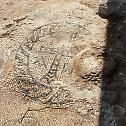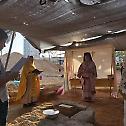Episcopal Liturgy at the Ruins of a 5th Century Byzantine Church in the Israeli City Ashdod (Ancient Coastal Azotos)
Around 1921, at the beginning of work at a construction site in a neighbourhood of south Azotos (present Ashdod), the digging machine uncovered mosaics of an old Byzantine Holy Church, with the result that the Archaeological Service of Israel intervened and prohibited the continuation of the works.
Ever since the specific plot remained empty and fell under the ownership of the state. In 2009, the Archaeological Service assigned the responsibility of the excavations to the specific plot to archaeologist Dr Alexander Fantalkin, Lecturer at Tel Aviv University, who specializes in Ancient Greece in the 8th century BC. The excavations were postponed and continued this year.
A building complex with a central temple and chapels of unique spiritual and historical value were discovered during the excavations. There is a possibility that it is associated with the existence of an early form of a Hesychastic Monastery for an Order of Virgin Women with the title Deaconess.
On Thursday morning, 16/29 July 2021, an outdoors Divine Liturgy at the ruins of the ancient Church was officiated by His Eminence Archbishop Theophanes of Gerassa, with the participation of the Reverend Archimandrites; Eudokimos, the Spiritual Father of Saint Savvas’ Lavra, Ignatios, Hegoume of Beit Sahour and Beit Jala, Constantine, Hegoumen of the Holy Monastery of Hozeva, Artemios, Hegoumen of Haifa, Leontios, Hegoumen of Rafeidia of Samaria, Marcellus, Hegoumen of Saint George in Lydda, and Farther Alexander Yasevitch, from the Russian-speaking flock in Beer Sheva.
After the Divine Liturgy, His Beatitude, our Father and Patriarch of Jerusalem Theophilos led a Trisagion for the repose of the souls of the departed Fathers of old, whose names are commemorated in the various inscriptions of the mosaic floor as:
Herakleios Bishop
Procopios Bishop
Karos Bishop
Gaianos Presbyter
Stephanos Presbyter
Maximos Deacon
Sophronia or Euphrosyni Mother
Severa Deaconess
Theodosia Deaconess
Gregoria Deaconess
Then, at the presence of the local authorities, namely the Vice Mayor of Ashdod, the team from the Archaeological Service of Tel Aviv University, His Beatitude was guided at the excavation site by Dr Alexander Fantalkin, and addressed those present underlining the importance of the excavation findings as a link between the Old and the New Testament and as a meeting place for researchers, pilgrims and tourists, inspiring to a life of creation, peace and civilization. His Beatitude’s address follows below:
“Mr Mayor,
Dr Fantalkin,
Ladies and Gentlemen,
It is a great pleasure for us to be here today at this significant site. This church, established by Bishop Procopios in the 6th century, is important evidence of the fact that Ashdod, known then as Azotos, was among the principal cities on the coast during the Byzantine period.
Ashdod has a long and noteworthy history, and we read about it in both the Old and the New Testaments. According to the Book of Joshua, it was given to the Tribe of Judah as their home (Joshua 15:46), and in the Acts of the Apostles, we read that Saint Philip found himself hereafter baptizing the officer of the court of the Ethiopian queen (Acts 8:40).
These are only two examples from its long history. But they speak to the fact that the Bible is a record of our shared sacred history. And the discovery of this Byzantine church, which is for us Christians a significant holy site, is a testimony to the witness that the Patriarchate of Jerusalem has given down the centuries to our sacred history. As the oldest religious institution in the region, the Patriarchate has embodied this sacred history and given it legitimacy.
We appreciate very much that the State of Israel and the Antiquities Authority are sensitive to the diverse civilizations that have existed in this region. This has always been a multi-cultural, multi-ethnic, and multi-religious landscape where different peoples have flourished down the ages. And we wish to recognise the hard work and commitment of Dr Fantalkin and the Faculty of Humanities of Tel Aviv University, to which the Department of Archaeology belongs, since the discovery of this site in 2017. They have borne the major burden of the work of this excavation and brought to light this invaluable heritage.
This site is both a holy site as well as a site of supreme historical and academic value. There is an existence of the Christian presence here even before this Church. We know that one of the bishops of this region, Bishop Silouanos, attended the First Ecumenical Council in Nicaea in the year 325. There are inscriptions at this church mentioning the name of Bishop Hierakleios, who participated in both the Third Ecumenical Council of Ephesus in 431 and the Fourth Ecumenical Council at Chalcedon in 451.
But we have here a site that, like Madaba and Megiddo, has the power to draw not only scholars but also tourists and pilgrims in large numbers. We have a treasure here that we must preserve and make accessible to the many hundreds of thousands of pilgrims who come to the Holy Land every year. As a site of such significant scientific and religious consequence, this site is of immense value to the City of Ashdod, and it is part of the common heritage of all humanity in the Holy Land.
At this site, many tombs have been discovered, including the graves of several women who bore the title deaconess. This confirms for us the existence of this office in the early Church. In addition to this, tombs of holy martyrs have been uncovered, which is proof that this place served as a liturgical gathering place before the 4th century. This is evidence that this place was a place of worship during the time of persecution. According to the writings of Saint John Chrysostom, the tombs of the martyrs were used as the altars where the divine Eucharist was celebrated. This discovery alone will draw the presence of pilgrims, both from the East and the West, who will want to venerate this holy site and who hold the martyrs from the age of persecution in high honour.
We thank you, Mr Mayor, for your care and concern for the preservation of this site that is a witness to our shared sacred history in this region. And we congratulate you, Dr Fantalkin, on your remarkable achievement in bringing this site to the attention of the world community. The conservation and development of this site by the local authorities would strengthen the existing good relations between the State of Israel and the Patriarchate of Jerusalem, and, by extension, with the Christian world in general and with the Orthodox world in particular, such as the nations of Greece, Cyprus, Russia, Rumania, Bulgaria, Serbia, Georgia and others.
In the preservation of this site, today’s residents of Ashdod will take pride in the further evidence of the historical and spiritual significance of their beloved city, and if we pay special attention to those who have preceded us and left an indelible stamp of their presence, we would expect future generations to preserve the evidence of our own lives and witness here. As we read in the Book of Psalms:
Then we your people, the flock of your pasture,
will give thanks to you forever;
from generation to generation, we will recount your praise.
(Ps 78 [79]: 13)
It is our fervent hope and desire that this site be preserved intact, and ultimately be made accessible both to scholars and to pilgrims, like all other holy places in our region. This would be a living testimony of the history of this ancient city and would promote peaceful coexistence, tolerance, and mutual respect. This would be a tangible symbol of the words we read in the Bible, that we are to pursue righteousness, godliness, faith, love, endurance, and gentleness (1 Tim. 6:11).
This is the mission of the Patriarchate, and we pledge ourselves to support and assist in this work. MAY this place be a source of both knowledge and spiritual refreshment for generations to come.
Thank you.”
This important event was organized by His Eminence Archbishop Aristovoulos of Madaba, who is responsible for the Russian-speaking flock of the Patriarchate. In the end, His Eminence offered the Patriarchal Entourage and all present, boiled wheat, refreshments and fruit.
Source: Jerusalem Patriarchate





